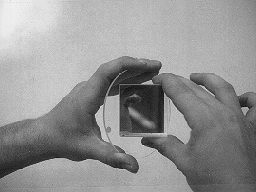

PURPOSE: To demonstrate the existence of the evanescent (boundary) wave in the less dense medium, when the incident wave suffers total internal reflection.
DESCRIPTION: Electromagnetic boundary conditions across a totally reflecting surface lead to a wave that dies off exponentially (within a few wavelengths) beyond the surface, but does not carry energy across it. However, this wave can be transmitted if it is made to interact with dense matter sufficiently close to the surface. The demonstration shows the hypotenuse face of a right angle prism acting like a perfect mirror, except for a spot around the point of contact with the lens. If the angle of incidence (on the hypotenuse) is close to the critical angle (42 degrees), a set of Newton's rings appear around the "spot." These can be used to measure the distance of penetration.
Close one eye. Let the reflected light come from a light area, the transmitted light from a darker area, or vice-versa.
SUGGESTIONS: Good for individual viewing.
REFERENCES: (PIRA 6A44.35, 7A50.12) See Demonstration Reference File for further information about this effect.
EQUIPMENT: 52 cm focal length convex lens, right angle prism.
SETUP TIME: None.
 |  |  |  | 
|